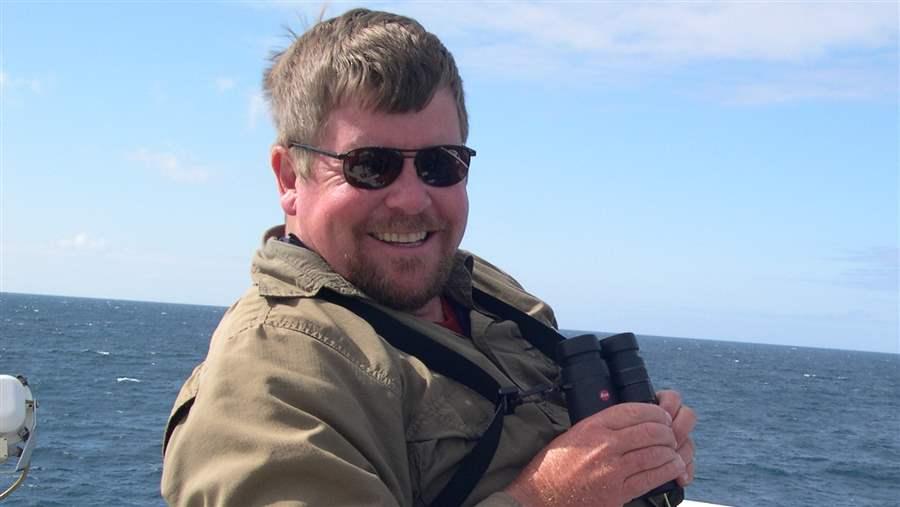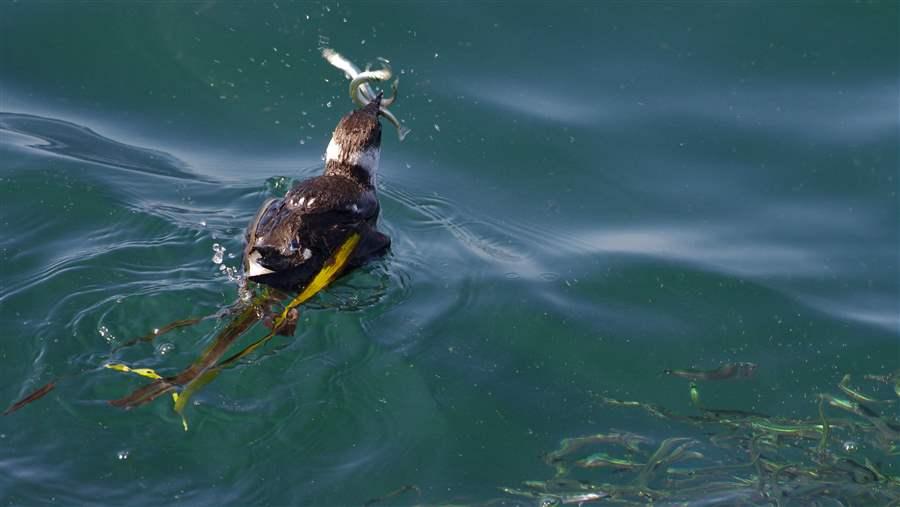‘A Healthy Ecosystem Depends on Forage Fish’
A Q&A with ocean champion Tim Shelmerdine
 © Courtesy of Tim Shelmerdine
© Courtesy of Tim ShelmerdineTim Shelmerdine leads excursions for seabird enthusiasts off the Oregon coast, home to one of the most productive marine ecosystems in the world thanks in large part to an abundant and diverse array of forage fish species. Oregon is considering a plan to protect forage fish in state marine waters.
“Skua!”
The bow of the 52-foot tour boat dips forward, then rises to meet the horizon.
“Skua!” the call comes again from veteran birder David Mandel. He’s spotted a south polar skua off the starboard bow, one of scores of sightings throughout a daylong offshore birding trip hosted by Tim Shelmerdine of Oregon Pelagic Tours. For many on the tour, this skua is a “life bird,” a species that a birder sees and identifies in the wild for the first time.
Visitors travel from around the world to experience the breathtaking beauty and wealth of Pacific Ocean fish and wildlife along the Oregon coast.
Shelmerdine, a professional birder and longtime teacher at Lakeridge High School near Portland, has been guiding tours off the Oregon coast for 20 years. He relishes each trip: the sight of a sooty shearwater gliding across the water, its wing tip delicately touching the surface; marbled murrelets in search of sand lance to carry back to nests perched in towering trees along coastal headlands; storm petrels and colorful puffins bobbing on the swells.
Through the Audubon Society of Portland, Shelmerdine has become active in encouraging West Coast fishery leaders to protect small, schooling species—collectively known as forage fish—that nourish seabirds, marine mammals, and bigger fish in the ocean ecosystem. With basic protection for West Coast federal waters (3 to 200 miles offshore) now in place, Shelmerdine is among the many voices calling on the Oregon Fish and Wildlife Commission to enact complementary protections for forage fish in state marine waters out to 3 miles offshore.
Pew sat down with Shelmerdine to talk about the Oregon coast and his work to protect the foundation of the Pacific Ocean food web.
Q: Do you see a connection between Oregonians, many of whom don’t necessarily live close to the beach, and the ocean?
A: It’s true that most of the state’s population is centered inland along the Interstate 5 corridor, but I’ve talked with coastal residents and visitors who both understand that we are blessed with an incredibly productive marine ecosystem. Even though I live in the Portland metro area, I try not to let too much time elapse before I get back to the ocean. I’m drawn to the salt air and the experience of being on the ocean. As a guide, I realize there are a lot of people who really want to see these animals. They will travel hundreds or thousands of miles and pay good money to see birds and marine mammals. That’s good money for me as a small-business owner, but it also generates business for hotels and restaurants in places like Newport.
Q: Why have you become active in supporting forage fish conservation?
A: You see things like the marbled murrelets diving for sand lance, pelicans and murres eating sardine and smelt, you see huge breeding colonies of these and other seabirds on rocky headlands like Yaquina Head. You see all this, and you realize that all of these seabirds are dependent on forage fish. I like the way Aldo Leopold put it: To keep every cog and wheel is the first precaution of intelligent tinkering. It’s a great way to look at ecosystems and food chains.
Q: What makes Oregon’s coast such a unique place?
A: The Oregon coast is special for its people as much as its scenery and wildlife. We have traditionally valued our ocean, perhaps best represented by [former Governor] Tom McCall in providing coastal public access open to residents and tourist alike. Even though we don’t have the sunbathing beaches that you see in California, we do have some of the most dramatic coastline in the United States with incredible resources in things like fishing, scenery, and whale-watching. Add in a vibrant restaurant scene that specializes in local seafood, and you can see why people have a huge interest in visiting the coast and protecting its natural attributes.
Q: Do you think we’re on the right track?
A: I do feel a little more optimistic than I felt five to 10 years ago because I think we’re being a little more analytic about how all the pieces fit together. A lot of people in Oregon get that you can’t just take what you want and leave nothing. Even though there is no fishing for sand lance now, we know that demand is high worldwide to catch forage fish species and turn them into products that aren’t eaten directly by people—like fish oil and meal turned into fertilizer or fed to livestock. It’s important to recognize that a healthy ecosystem depends on forage fish, and we should make sure we account for the needs of seabirds and other fish and wildlife before exploiting their prey.
Q: Why do you think it’s important for Oregon to act now?
A: The Pacific Fishery Management Council agreed to protect unmanaged forage fish like sand lance and Pacific saury in federal waters offshore, but we know the nearshore environment is every bit as important because that’s where we see a lot of seabirds, whales, and bigger fish. It’s important for Oregon to protect these same forage fish species within 3 miles of shore. You have certain species of seabirds that almost exclusively feed within that zone. You’ll see marbled murrelets in the breakers out to 2 miles offshore, and you don’t find them any farther than that. With the decline of coastal old growth forest habitat from logging over the past century, it’s important to protect the pieces that we can. We’ve made great strides through the Oregon Marine Reserves Partnership and specific initiatives like the Central Coast Marbled Murrelet Important Bird Area. Now it’s time to protect the food sources for these birds.
 © Wayne Hoffman
© Wayne HoffmanA juvenile marbled murrelet feasts on a school of sand lance near Yaquina Bay in Oregon. Sand lance is one of the species that would be protected under a forage fish management plan proposed by the Oregon Department of Fish and Wildlife.
Q: Seabirds are strong indicators of the health of marine ecosystems. Have you seen changes in the 20 years that you’ve been leading tours and the 30 years since you started watching seabirds?
A: Seabirds will go where they can find food. We’ve been fortunate here in Oregon because we happen to live near some of the most nutrient-rich ocean water in the entire world. We get these upwellings of cold water from the deep that supply nutrients to feed krill, which feed forage fish, which then feed everything else. This year and last, we’ve seen the disruptive effects of El Nino on ocean productivity. For one example, we don’t see the numbers of black-footed albatrosses that we used to see. In past years, we’d see as many as 400 on a trip. In recent years, we might hope to see as many as 100 in a day.






